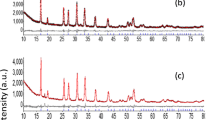Abstract
The electrochemistry of molten LiOH–NaOH, LiOH–KOH, and NaOH–KOH was investigated using platinum, palladium, nickel, silver, aluminum and other electrodes. The fast kinetics of the Ag+/Ag electrode reaction suggests its use as a reference electrode in molten hydroxides. The key equilibrium reaction in each of these melts is 2 OH− = H2O + O2− where H2O is the Lux-Flood acid (oxide ion acceptor) and O2− is the Lux–Flood base. This reaction dictates the minimum H2O content attainable in the melt. Extensive heating at 500 °C simply converts more of the alkali metal hydroxide into the corresponding oxide, that is, Li2O, Na2O or K2O. Thermodynamic calculations suggest that Li2O acts as a Lux–Flood acid in molten NaOH–KOH via the dissolution reaction Li2O(s) + 2 OH− = 2 LiO− + H2O whereas Na2O acts as a Lux–Flood base, Na2O(s) = 2 Na+ + O2−. The dominant limiting anodic reaction on platinum in all three melts is the oxidation of OH− to yield oxygen, that is 2 OH− → 1/2 O2 + H2O + 2 e−. The limiting cathodic reaction in these melts is the reduction of water in acidic melts ([H2O] ≫ [O2−]) and the reduction of Na+ or K+ in basic melts. The direct reduction of OH− to hydrogen and O2− is thermodynamically impossible in molten hydroxides. The electrostability window for thermal battery applications in molten hydroxides at 250–300 °C is 1.5 V in acidic melts and 2.5 V in basic melts. The use of aluminum substrates could possibly extend this window to 3 V or higher. Preliminary tests of the Li–Fe (LAN) anode in molten LiOH–KOH and NaOH–KOH show that this anode is not stable in these melts at acidic conditions. The presence of superoxide ions in these acidic melts likely contributes to this instability of lithium anodes. Thermal battery development using molten hydroxides will likely require less active anode materials such as Li–Al alloys or the use of more basic melts. It is well established that sodium metal is both soluble and stable in basic NaOH–KOH melts and has been used as a reference electrode for this system.
Similar content being viewed by others
References
V. Klasons, in D. Linden (Ed.), ‘Handbook of Batteries’ (McGraw-Hill, New York, 2nd edn 1995), pp. 22.1-22.22.
M.H. Miles, Recent advances in lithium battery technology, in ‘23rd Annual GaAs IC Symposium Technical Digest 2001’ IEEE, Piscataway, NJ (2001), pp. 219-222.
M.H. Miles, Lithium thermal batteries using molten nitrate electrolytes, in ‘Proceedings of the 39th Power Sources Symposium’, Cherry Hill, NJ (2000), pp. 560-563.
M.H. Miles, Electrochemistry of molten nitrate electrolytes and applications for high voltage lithium cells, in ‘Meeting Abstracts’, Vol. 2001-2, The Electrochemical Society, Pennington, NJ (2001), Abstract 125.
J.A. Plambeck, in A.J. Bard (Ed.), ‘Encyclopedia of Electrochemistry of the Elements, Fused Salt Systems’, Vol. 10 (Marcel Dekker, NY 1976), pp. 283-318.
N. Saib, P. Claes and J. Glibert, Electrochim. Acta 43 (1998) 2089.
P. Claes, Y. Dewilde and J. Glibert, J. Electroanal. Chem. 250 (1988) 327.
P. Tilman, J.P. Wiaux, C. Dauby, J. Glibert and P. Claes, J. Electroanal. Chem. 167 (1984) 117.
J.P. Wiaux and P. Claes, J. Electrochem. Soc. 129 (1982) 123.
D. Sandford, L.N. Marquez and A.M. Stacy, Appl. Phys. Lett. 67 (1995) 422.
A. Eluard and B. Trèmillon, J. Electroanal. Chem. 30 (1971) 323.
P. Claes, F. Mernier, L. Wery and J. Glibert, Electrochim. Acta 44 (1999) 3999.
P. Claes, G. Peeters and J. Glibert, J. Electrochem. Soc. 136 (1989) 2599.
S. Zecchin, G. Schiavon and G.G. Bombi, J. Electroanal. Chem. 50 (1974) 261.
J. Goret and B. Trèmillon, Bull. Soc. Chim. Fr (1966) 67.
Author information
Authors and Affiliations
Rights and permissions
About this article
Cite this article
Miles, M. Exploration of molten hydroxide electrochemistry for thermal battery applications. Journal of Applied Electrochemistry 33, 1011–1016 (2003). https://doi.org/10.1023/A:1026270119048
Issue Date:
DOI: https://doi.org/10.1023/A:1026270119048




